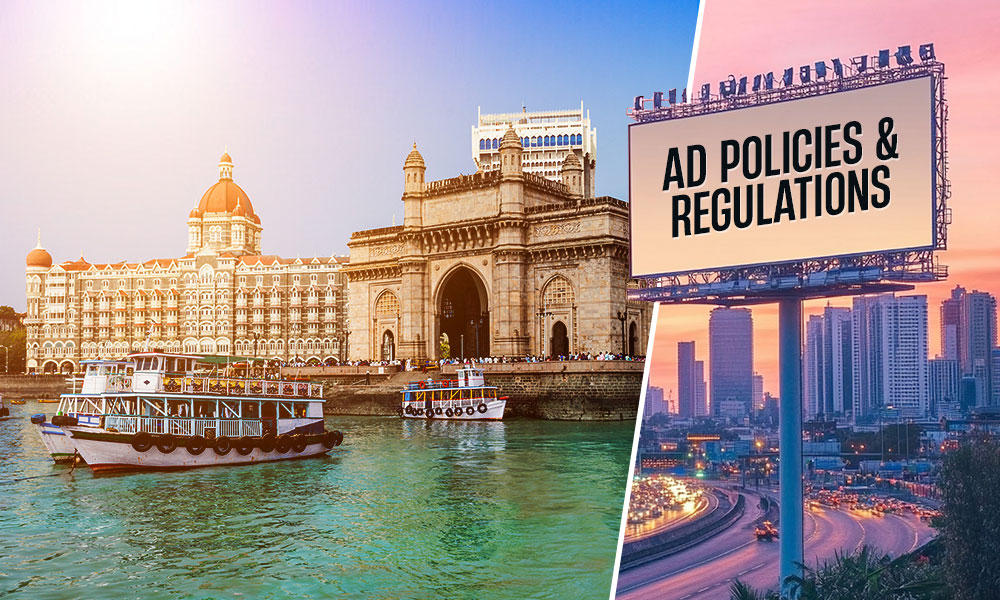Ad Policies & Regulations
Navigating the new OOH policy: Mumbai’s media owners voice their concerns and proposals
As the Brihanmumbai Municipal Corporation (BMC) wraps up its feedback phase on the new draft Out-of-Home (OOH) advertising policy, key industry players share their insights on the challenges ahead, the potential impact on client relationships, and their proposed solutions for a balanced regulatory framework.

As the Brihanmumbai Municipal Corporation (BMC) concluded its window for receiving suggestions on the new draft Out-of-Home (OOH) advertising policy on August 26, media owners in Mumbai are now reflecting on the potential impacts of the proposed regulations. The new policy, which aims to regulate outdoor advertising to enhance the city’s aesthetics and safety, has elicited diverse reactions from industry stakeholders. In this extended exploration, three prominent voices in the industry—Gaurav Vasudeva, Director at Pioneer Publicity; Junaid Shaikh, Managing Director at RoshanSpace Brandcom; and Devesh Mittle, Partner at D S Mittle share their thoughts on the immediate challenges posed by the policy, its impact on client relationships, and the suggestions they’ve submitted to the BMC.
Immediate challenges due to the new policy

Gaurav Vasudeva, Director at Pioneer Publicity
Talking about the immediate challenges faced in the wake of the draft policy, Gaurav Vasudeva, Director at Pioneer Publicity said, “The implementation of the new OOH policy has introduced several challenges that are causing concern among media owners. From my perspective at Pioneer Publicity, one of the most pressing issues is the delay in obtaining approvals that have been pending for several months. These delays have been exacerbated by the new policy’s requirements, which add layers of complexity to the process. For example, the policy now mandates that media owners must apply for renewals three months in advance, as opposed to the previous system that followed the calendar year. This shift in the timeline could force us to redirect significant resources and manpower during peak business seasons to manage the renewal process. Such disruptions could have a ripple effect on our operations, potentially impacting our ability to deliver on commitments to clients.”

Junaid Shaikh, MD, RoshanSpace Brandcom
Adding on to this point, Junaid Shaikh, Managing Director, RoshanSpace Brandcom highlighted, “At RoshanSpace Brandcom, the challenges are equally daunting. Our commitment to enhancing Mumbai’s skyline through innovative, large-format installations has involved substantial investments, totalling Rs 70-80 crore, since the pandemic period. However, the new policy’s decision to reduce the minimum distance between billboards from 100 metres to 70 metres raises serious concerns. This reduction could lead to visual clutter, which not only undermines the aesthetic appeal we strive to maintain but also poses potential safety risks. We fear that this change could result in the doubling of billboards across the city, diluting the impact of our carefully curated installations and detracting from Mumbai’s visual appeal. Another challenge is the policy’s ambiguity regarding what constitutes “illegal” billboards. The lack of clarity on this issue puts media owners like us in a precarious position, as it leaves room for arbitrary enforcement. This uncertainty, coupled with a collective punishment approach where the actions of a few could penalise the entire industry, only adds to the strain.”

Devesh Mittle, Partner, D S Mittle
Devesh Mittle, Partner, D S Mittle, adds to this point by saying, “From the perspective of D S Mittle, the new policy seems to exacerbate issues that the previous 2008 policy had attempted to address. The earlier policy was designed to reduce visual pollution from outdoor advertisements, a goal that we fully supported. However, the new policy appears to introduce complications by encouraging new advertising formats, such as MUPI advertising, compound wall ads, and smaller signage. These new formats have the potential to increase visual clutter rather than reduce it. Moreover, the policy’s inconsistent application of distance criteria—whereby hoardings are subject to stricter rules than other mediums like MUPIs or bus shelters—further complicates the situation. This inconsistency could lead to public dissatisfaction and regulatory challenges, as it creates a sense of unfairness among media owners and the public alike.”
Impact on client contracts
Highlighting the impact on client contracts, Gaurav said, “The policy’s impact on our relationships with clients is another area of significant concern. At Pioneer Publicity, we are cautiously monitoring how the new restrictions might affect our contracts. There is a possibility that we may need to renegotiate some agreements to align with the new regulatory environment. The uncertainty surrounding the policy’s implementation makes it difficult to provide our clients with clear guidance, which could strain these relationships. While it’s still early to fully assess the overall impact, we are preparing for the possibility that some clients may seek adjustments to their contracts or, in the worst-case scenario, choose to part ways due to the constraints imposed by the new policy.”
Junaid added his concerns and said, “For RoshanSpace Brandcom, the situation is even more challenging. As a leading player in Mumbai’s OOH space, our reputation is built on delivering impactful, aesthetically pleasing advertising solutions. The abrupt changes introduced by the policy have thrown a wrench into our operations, leading to significant disruptions. We now find ourselves in the difficult position of having to renegotiate or even cancel existing contracts with advertisers. This situation not only jeopardises our financial stability but also threatens the long-term relationships we’ve built with clients who have trusted us to elevate their brands through our premium assets. The livelihoods of thousands of labourers and countless vendors associated with the OOH industry are also at stake, further exacerbating the impact of these policy changes. Our clients value the exclusivity and aesthetic appeal that our assets provide, but with the policy’s restrictive measures, we risk losing that edge, which could lead to a decline in client confidence and future investments.”
Putting his point forward, Devesh said, “At D S Mittle, the new draft policy has indeed had some impact on client relationships. We’ve noticed an increase in clients seeking reassurance about the legality of our hoardings. Some have requested documentation to confirm that we comply with all regulatory requirements, which has led to some renegotiation and background checks. However, we’ve been able to manage these concerns, as most of our hoardings in Mumbai are legal and compliant with existing regulations. We’re prepared to provide any necessary documentation to reassure our clients and maintain their trust. Over time, as the industry adjusts and the impact of the new policy becomes clearer, we expect these concerns to diminish.”
Suggestions for the draft policy
Talking about BMC taking suggestions for the draft policy, Gaurav said, “Despite the challenges, we have taken proactive steps to submit our suggestions for the draft policy. Our main focus is on ensuring that the policy is fair, practical, and supportive of the growth and sustainability of the OOH advertising industry in Mumbai. We believe that a well-considered policy should balance the need for regulation with the realities of running a business in this sector. Our suggestions emphasise the importance of maintaining a streamlined approval process, especially during peak business seasons, to avoid unnecessary disruptions. We also advocate for greater clarity in the policy’s guidelines to reduce the potential for arbitrary enforcement and ensure that all stakeholders are on the same page.”
Stating his concerns, Junaid said, “At RoshanSpace Brandcom, we understand and appreciate the BMC’s intent to enhance safety and aesthetics in Mumbai’s urban landscape. However, we believe that the current policy, in its present form, falls short of addressing the industry’s needs. As stakeholders who are deeply invested in Mumbai’s urban landscape, we’ve emphasised the need for a collaborative approach in developing a more balanced and effective policy. Our suggestions include maintaining aesthetic standards, limiting the number of media assets to avoid clutter, and integrating technology and measurement tools to enhance safety and effectiveness. We also advocate for the involvement of reputable third-party institutions, such as IIT or VJTI, in the certification process to ensure the structural integrity of billboards. Moreover, we’ve urged the BMC to reconsider the timeline for feedback. The limited window for submitting suggestions, compounded by recent bank holidays, has hindered our ability to fully engage with the process. Extending this timeline would allow all stakeholders, including media owners and concerned citizens, to contribute their valuable insights, leading to a more comprehensive and effective policy.”
Adding his inputs, Devesh said, “We’re actively preparing our response to the draft policy. We’ve been gathering feedback from our association members and seeking legal opinions on how best to address the issues raised by the new regulations. Our goal is to submit suggestions that ensure a fair and balanced approach to all advertising mediums, not just hoardings. We’re particularly focused on addressing the inconsistencies in the application of distance criteria across different advertising formats. By highlighting these issues, we hope to influence the BMC to adopt a more uniform and equitable approach that treats all advertising mediums fairly. We believe that our input, which is well-informed and constructive, will contribute to a more effective policy that benefits all stakeholders.”
As media owners across Mumbai await the BMC’s next steps in finalising the new OOH policy, the perspectives shared by Gaurav Vasudeva, Junaid Shaikh, and Devesh Mittle highlight the complexities and challenges posed by the proposed regulations. Each of these industry leaders has provided valuable insights into the immediate challenges, potential impacts on client relationships, and the importance of a collaborative approach in shaping the future of OOH advertising in Mumbai.
The hope is that the BMC will carefully consider the suggestions submitted by industry stakeholders and work towards creating a regulatory framework that not only promotes innovation and ensures public safety but also preserves the aesthetic integrity of Mumbai’s skyline. By fostering open dialogue and collaboration, there can be a policy that benefits all parties involved and contributes to the vibrant urban landscape of Mumbai. The OOH industry maintains that they remain committed to working with the authorities to create an that supports the growth and sustainability of the OOH advertising sector in the city.
-

 Campaigns
CampaignsNetflix India goes full green light on OOH with Squid Game season 2
-

 Creative Concepts
Creative ConceptsSkechers launches 3D cricket shoe Bus Shelters in Mumbai
-

 Campaigns
CampaignsBeing Human marks Salman Khan’s birthday with a bold OOH campaign
-

 Sustainability
SustainabilityStatus of sustainable printing in the OOH Industry: Challenges and pathways forward
























